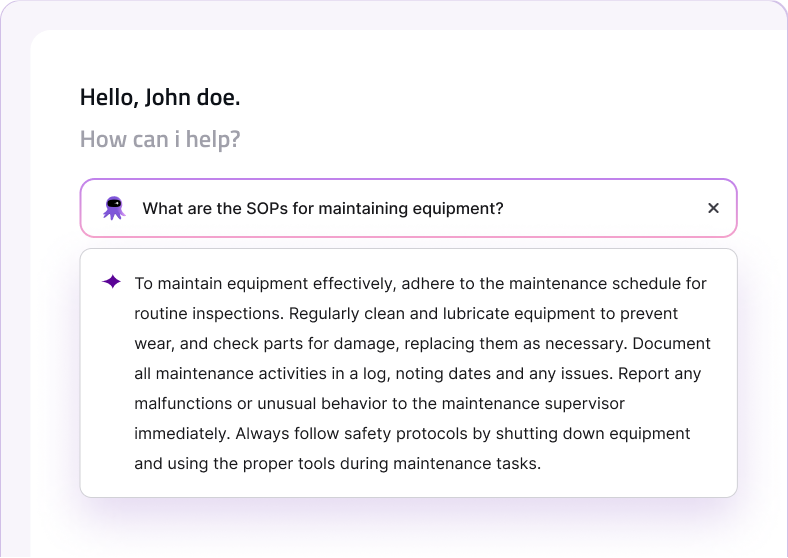Do you want to boost the operational efficiency of your business? Can knowledge management help, but are not sure how?
Well, congratulations, you are off to a good start!
It is agreed that resource optimization, process reviewing, and automating, etc., are very important factors in improving operational efficiency. But making data more accessible drives factors like cross-team collaboration, improved decision-making, better innovation, and reduced employee stress.
Especially when it comes to a quality-focused metric such as operational efficiency, we must look at ways to improve ‘how’ well the work is getting done, vis-à-vis, how much work is getting done. And without an efficient knowledge management system in place, this ‘how’ will always remain a little messy.
But rather than making blank statements, let me prove to you how knowledge management improves operational efficiency. This is where we begin, and once you are convinced of its importance, we move on to discussing knowledge management tips that improve operational efficiency in the real world.
Let’s get to it!
How Does Knowledge Management Improve Operational Efficiency?
To truly enhance operational efficiency, organizations must go beyond streamlining processes; they need to ensure the proper knowledge is easily accessible, consistently shared, and effectively used. Here’s how knowledge management plays a direct and powerful role in optimizing the way your business runs every day.
Speeds up access to important information
Each employee, and in turn, the entire business, depends on data to make informed decisions. From analyzing market trends to monitoring customer behavior and tracking resource utilization, nothing happens without access to important information in the form of data or knowledge.
However, research shows that the frustration of having to search for information across the organization is so great that 43% of employees would consider leaving a job if there weren’t an efficient way to access it.
But with dynamic knowledge management tools like a centralized knowledge base or bases providing easy and quick access to knowledge, employees don’t have to go through this turmoil.
The knowledge base is accessible 24×7 across time zones, giving information access to in-office as well as remote teams, ensuring maximum operational efficiency.
Encourages collaboration and innovation
Irrespective of the organization’s size, collaboration is crucial among teams to leverage their diverse skills for problem-solving, innovation, and truly working towards one goal as one entity. This becomes even more important in the present hybrid work environment, where employees may not even have met each other in person and miss real-life connections.
Knowledge management tools facilitate collaboration by bringing everyone on the same system instead of working in silos. Real-time knowledge sharing through such tools increases engagement and strengthens teams’ relationships.
And it is only when communication is smooth without any bottlenecks and teams work together that true innovation really starts to happen.
Retains critical knowledge when employees leave
The real capital of a company is its knowledge, and a large part of this knowledge is present in terms of individual expertise and insights gained by individuals through working over a period. But as employees retire, move companies, or take another role within the organization, this knowledge may not be accessible anymore.
This intellectual loss reflects at multiple levels in an organization, including in its operational efficiency.
However, organizational learning with knowledge management eliminates potential loss, as all the information is gathered and stored in a centralized repository. It not only retains knowledge as employees leave, but also removes dependence on any individual while they are with the organization, saving time on both ends.
Improves problem-solving and decision-making
If the teams are taking decisions in silos, it can create real operational crisis. The case of overpromising by sales and under-delivering by operations is a classic and clichéd example of this fact. Some other operational crisis scenarios can be:
- Marketing is promoting a feature as live while it is still under development.
- The support team is reporting recurring bugs and requesting a certain feature, but the engineering department is prioritizing other tasks.
- The procurement team continues ordering based on outdated demand forecasts, unaware that the product demand has changed.
However, when all teams are on the same page with efficient knowledge management, such problems can be completely avoided.
Also, as teams can access and share knowledge in real time, they make better decisions overall and help each other troubleshoot issues and resolve problems faster.
Boosts work quality and productivity
As per the latest research, employees spend, on average, at least two hours a day (25% of their work week) looking for the documents, information, or people they need to do their jobs.
This is appalling considering this percentage was 19%, per a pre-pandemic research by McKinsey.
So, even though research has been warning businesses about this huge organizational loss caused by poor knowledge management, it still remains a largely ignored area.
Now, imagine you have an efficient knowledge management system in place, and your employees are investing these two hours every day not in searching for knowledge to do their jobs, but doing it!
Productivity will naturally boost, and with increased engagement, collaboration, and better decision-making that comes with knowledge management, work quality will be better, too.
Reduces employee stress by providing needed resources
With knowledge management in place, your employees know exactly where to go when they need information. Their work experience is completely transformed, as instead of running to different resources, now they have the time to simply take the information and do what they need to.
This results in reduced stress and pressure and an enhanced sense of well-being in your employees. They feel more engaged and valued and are encouraged to give their best in return.
And, given the fact I mentioned before that nearly half of the workforce (43%) was inclined to leave their jobs because of this stress, if you can achieve this one thing successfully, that is a pretty great achievement.
Now is the time to look at some tips to implement knowledge management in your organization successfully.
Make knowledge easily accessible and improve your team’s efficiency with Document360. Start your free trial today!
GET STARTED
Knowledge Management Tips to Improve Efficiency
Knowing that knowledge management can boost operational efficiency is only half the equation; putting it into practice is what drives real results. Below are actionable tips to help you implement knowledge management that directly supports smoother operations, more thoughtful decisions, and a more productive workforce.
Establish a knowledge-first culture
In the present era, where almost 70% of the world population uses the internet to create, share, and absorb new information freely, it is astonishing how reserved people are about information within an organization.
But it may not be because they don’t want to do it, but because that is not the organizational style. So, it is very important to establish and encourage a knowledge-first culture in your business for knowledge management to be used to its full potential.
The leadership must communicate how knowledge sharing and innovation will drive the organization forward, and a comprehensive knowledge management strategy must be created.
Collaborative tools must be implemented, and continuous learning and development must be encouraged as part of the organizational style, not as a one-time event.
Curate before creating new content
Before you start creating new content, you must use all the content/ knowledge that already exists. It is possible that all you need to implement a knowledge management system already exists, and you simply need to give it a clear structure.
A robust knowledge management framework (KMF) is crucial to do this. Such a framework allows businesses to effectively capture and leverage their existing knowledge assets, resulting in enhanced productivity, engaged employees, and overall success.
Integrate KM into daily workflows
To ensure knowledge management has a direct impact on your operational efficiency, you must integrate it into your daily workflows.
To do this, start documenting your process workflows in case they are scattered. Once you do this, you can find knowledge gaps in each workflow, if any. Then, with strategic planning, clear goal-setting, and gradual integration, you can start filling these knowledge gaps, and as time goes this process will become more organic.
Please remember that knowledge management must be treated as a continuous process and not a one-time implementation for it to be effective.
Ensure knowledge is easy to access and search

Any knowledge management effort is successful only when the knowledge that’s been made available is easy to access and search. Some of the ways you can do this are:
- Assign a knowledge management owner who creates content management plans by organizing, categorizing, and tagging information for easy accessibility.
- Promote user-friendly knowledge formats such as step-by-step guides instead of lengthy manuals and FAQs instead of lengthy articles. Also, use multimedia tools like visuals and videos to make learning engaging and interactive.
- Invest in advanced search capabilities such as AI assistants. AI-driven search tools prioritize search intent, thereby understanding user queries better and faster. As your customers use these tools, they analyze user behavior and preferences over time and provide personalized content recommendations, enhancing the overall user experience.
Use a dedicated knowledge management tool
Choosing the right tool for knowledge management is crucial as it can make or break the entire process. It must match your current and future requirements and fit into your budget.
Some important features you must consider are the number of users it supports, the types of information you need to capture, branding and integration options, collaboration capability, AI-powered search, scalability with its cost implications, and rich media support.
A great example of this in action is Woods Bagot, a global architectural and consulting practice. They adopted Document360 to build a centralized, easy-to-manage knowledge base for their team. With Document360’s intuitive interface and robust features, Woods Bagot was able to streamline knowledge creation and sharing across departments, improving both collaboration and operational efficiency.
Michelle Van Kolck, Global Specialist-Design Technology at Woods Bagot, says
We aimed to revolutionize our teaching methodology by converting knowledge into actionable tasks. Document360 played a vital role in this transformation, integrating screen grabs, videos, and embedded PDFs as needed. There has been a clear enhancement in productivity and efficiency among individuals. The rise in usage also suggests that people are relying less on seeking help from others and instead referring to the knowledge base for assistance.
This case illustrates how the right KM tool can transform internal workflows and empower teams with fast, reliable access to critical information.
Enable continuous updates and user feedback

Last but not least, take feedback from all stakeholders about how the knowledge management system is working for them.
Understand what’s not working for them and ensure that the system is changed to remain relevant and user-friendly.
▶ Check out our video with Cloudflare’s Caley Burton on building strong content operations and tackling content debt.
Wrapping Up: Why Knowledge Management Is Key to Operational Success?
Operational efficiency isn’t just about doing more with less; it’s about doing better with what you already have. And nothing empowers that transformation like strategic knowledge management. As we have seen, it directly addresses many hidden inefficiencies, including wasted time, fragmented workflows, communication silos, and the silent erosion of expertise when employees leave.
A well-executed knowledge management system is an essential infrastructure if you are serious about improving your business’s daily operations. Please don’t treat it as an IT project or a documentation exercise. Treat it as a shift in organizational mindset. Invest in the right tools, embed KM into daily workflows, and foster a culture that values knowledge sharing as much as performance metrics.





 –
– 

